Each Way Betting Tips that can take you from beginner to pro, we have compiled some top tips below for you enjoy. Favorites win only about 30% of horse races. This eye-opening stat shows why smart punters are turning to each way betting as a reliable strategy to get consistent returns.
Backing favorites might look like the safest bet, but I found that there was a clever alternative in each way betting – especially in races with 8 to 12 runners. Punters can get a real edge over bookmakers by backing horses at odds of 7/1 or shorter for a place.
Each way betting’s strength comes from its dual nature. You place two separate bets – one for the win and one for the place. Your bet can still make money even if your horse doesn’t finish first. Many punters’ profits can get pricey when they don’t grasp the math behind these bets.
My 13 proven tips show what successful punters do to maximize their each way betting profits. These strategies help you spot value opportunities, particularly in races where shorter-priced horses give better returns than expected.
Understanding Each Way Betting Fundamentals
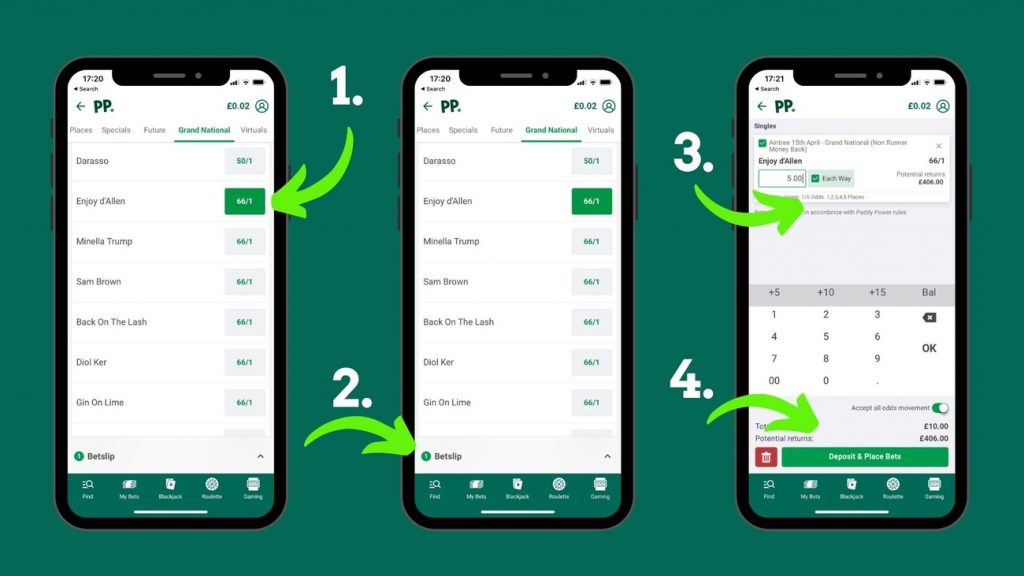
Each way betting stands out as one of the most flexible betting options you can find. Many punters still haven’t learned how it really works. Unlike simple win bets, each way bets give you a safety net that can turn losses into wins.
What Does Each Way Mean in Betting?
Each way bet combines two separate bets into one package – a bet on your selection to win and another bet on it to place. Your stake splits equally between these two parts, which means you’ll pay double what you would for a regular win bet. A £10 each way bet costs £20 total – £10 goes to the win part and £10 to the place part.
The Mathematics Behind Each Way Bets
The place portion pays a fraction of the win odds – usually 1/4 or 1/5 of the original price. These fractions change based on race type and how many horses run. Regular races with 8+ runners usually pay 1/5 odds for the first three places. Handicaps with 16+ runners typically give 1/4 odds for the first four places.
Place terms work like this:
- 1-4 runners: win only (no place)
- 5-7 runners: two places at 1/4 odds
- 8+ runners: three places at 1/5 odds
- 12-15 runners (handicaps): three places at 1/4 odds
- 16+ runners (handicaps): four places at 1/4 odds
Win and Each Way Meaning Explained
The main difference between win and each way betting shows up in their risk-reward balance. Win bets can pay more since all your money goes on one outcome. Each way bets give you two chances to make money. Let’s look at a £5 each way bet (£10 total) on a horse at 10/1. A win gets you both the win return (£55) and the place return (£17.50 at 1/4 odds), adding up to £72.50. If your horse just places, you’ll get the £17.50 place return.
Common Misconceptions About Each Way Betting
punters often think each way betting always gives better value. The race structure and odds determine if that’s true. Each way betting doesn’t always work best for longshots – backing favorites each way sometimes makes more mathematical sense.
Field size creates another common confusion. “Dead-eight” races (exactly eight runners) and 16-runner handicaps can give each way punters an edge because they sit right at the cutoff between different place term categories. The largest longitudinal study of 2018 Flat races showed that each way betting worked best in specific cases: 5-runner non-handicaps, 8-10 runner non-handicaps, 8-runner handicaps, and 16-17 runner handicaps.
Each Way Betting Tips – Identify Value in Short-Priced Favorites
Most people believe betting on longshots is the way to go, but short-priced favorites give you better value in each way betting. Math tells a different story than many punters think.
Why Odds Under 7/1 Offer Better Each Way Value
Professional punter Don Scott made this crystal clear: “The punter has an advantage over the each-way bookmaker in fields of 8 to 12 runners if he backs each-way horses quoted at 7/1 or shorter for a win”. Your edge gets better with shorter odds – something most punters miss completely.
Bookmakers face a tough spot – they can’t set different odds for win and place parts of each way bets. This means strong favorites force them to inflate win odds on other horses, while fixed place terms create sweet spots for value.
The betting industry calls these “dirty” or “snide” each way bets – races where you have a strong favorite (usually odds-on) and second and third favorites with great place chances. Bookmakers hate these situations because they must offer inflated place odds.
Calculating Expected Returns on Short-Priced Favorites
Finding value when choosing Each Way Betting Tips means comparing bookmaker place terms with true place probability. Let’s look at backing a horse at 5/1 each way in an 8-runner race with 1/5 odds for three places – the place portion pays at 1/1 (even money).
The math works out like this:
- Divide original odds by place terms fraction (5/1 ÷ 5 = 1/1)
- Compare this to the true probability of placing
- Value appears when your expected place rate beats implied probability
Bookmakers often get it wrong with horses priced between 4/1 and 7/1, especially in races with clear favorites.
Real-Life Examples of Value
Picture this race scenario: An odds-on favorite at 1.67, with a second favorite at 5.00. A 9-runner race paying 3 places at 1/5 odds would give you 1.80 for the second favorite placing. Betting exchanges might price the true place probability at 1.45 – that’s a big deal as it means you’ve found real value.
Professional punters target favorites at 2/1 and sometimes go shorter (down to evens) for a good reason. Backing at 2/1 each way gives you a place portion of 2/5 (or 0.40/1) – basically 2/1 ON for the place. This becomes amazing value when your horse looks certain to place.
Restricted class races at provincial meetings with uncompetitive fields usually offer the juiciest profits. Backing short-priced horses each way instead of just to win helps me exploit the math gaps in bookmaker pricing models.
Avoid Each Way Traps with Long Odds Selections
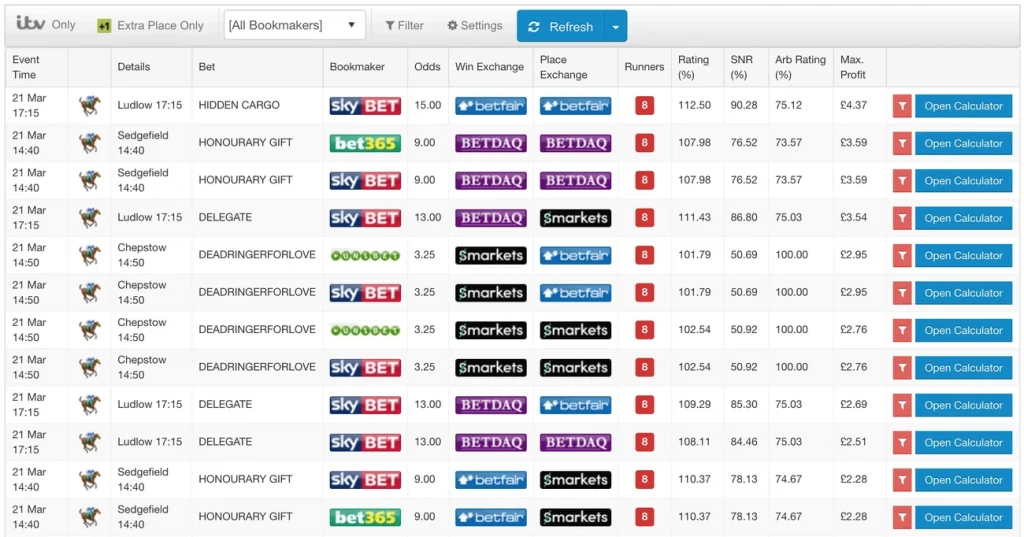
Big payouts from longshot horses tempt many punters. Yet, seasoned punters know that each way betting becomes less favorable as odds get longer. Bookmakers see these long odds selections as their most profitable each way opportunities.
Long Odds Work for Bookmakers
Bookmakers craft each way terms to draw punters toward high-odds horses. Their strategy works simply – they lure punters with promises of huge returns. The math always favors the house. Many punters wrongly believe each way betting gives better value on longshots. The reality proves quite different.
Each way betting requires double stakes – one bet to win and one to place. This creates a major disadvantage when backing outsiders. The place fraction, usually 1/4 or 1/5, applied to long odds results in place returns that don’t match the risk.
Each Way Bets Above 8/1 Face Math Problems
Math shows 8/1 hits the sweet spot for each way betting. The value drops faster beyond this point. Bets under 8/1 can pay off if your horse wins or places. Higher odds mean the place portion pays less compared to your doubled stake.
Let’s look at the numbers. A £10 each way bet totaling £20 on a 10/1 pick that finishes second gives return odds of just 5/4 with standard 1/4 place terms. Such modest returns don’t justify doubling your stake versus betting to win.
Better Ways to Play Long Shots
Horses at double-digit odds offer better value through other approaches:
- Win-Only Betting: Back the horse just to win. Accept higher volatility but avoid the place bet trap.
- Betting Without Market: Back a horse to win by leaving out the favorite.
- Split Stakes Strategy: Put more money on the win than the place portion to get better potential returns.
Smart bankroll management works better with long-odds picks. Use smaller stakes to match the higher volatility.
Numbers show that picking shorter-priced horses with discipline leads to better long-term profits than chasing huge longshot payouts.
Analyze Field Size Before Placing Each Way Bets
Field size stands out as one of the most crucial factors that many overlook when betting each way. Smart punters carefully study the number of runners before placing their wagers. They know that even small changes in field size can reshape their potential returns.
How Field Size Affects Place Terms
The number of runners directly shapes the place terms that bookmakers provide. Savvy punters use these distinct thresholds to their advantage. The standard place terms follow these patterns:
- 5-7 runners: Two places paid at 1/4 odds
- 8+ runners: Three places paid at 1/5 odds
- 12-15 runners (handicaps): Three places paid at 1/4 odds
- 16+ runners (handicaps): Four places paid at 1/4 odds
A non-runner can substantially change your potential returns. To cite an instance, see what happens when an 8-runner race drops to 7 runners – bookmakers pay only two places instead of three. This change could turn a winning bet into a loss.
Optimal Field Sizes for Each Way Value
Races with 8-12 runners usually provide the best value for each way betting. These “sweet spot” races strike the perfect balance between place probability and bookmaker terms. “Dead-eight” races create excellent advantages because they sit right where three places become available.
Handicap races with 16 runners present another mathematical sweet spot. A newer study, published in 2014 by racing analysts, showed that much of the races (53.69%) had eight or more runners. This created valuable opportunities with three each way places.
When to Avoid Each Way Betting in Large Fields
Larger fields shift the mathematical advantage toward bookmakers. Fields with 21+ runners offer place odds (1/4 or 1/5 the win odds) that don’t reflect the true place probability.
Consider a 21-runner race where all horses have equal chances. Fair win odds would be 20/1, which makes fair place odds around 6/1. Yet bookmakers typically offer only 5/1 for the place portion. This creates a big edge in their favor.
British racing’s average field size has dropped by about two horses per race over the last several years. Large fields are now rare. This trend leaves fewer races suitable for each way betting, and the average of 8.06 runners per race makes the three-place threshold a close call for punters.
Master Place Terms Across Different Race Types
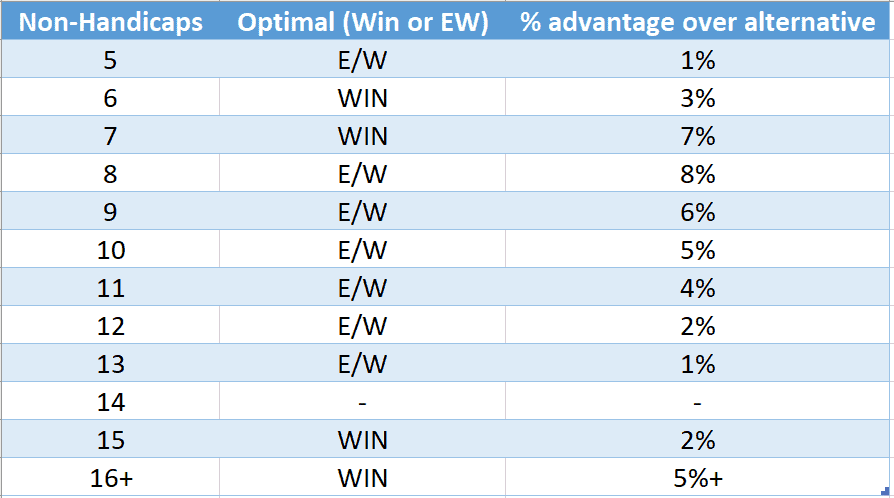
Place terms vary between race types, and understanding these differences is vital to boost your each way betting returns. Many punters overlook these unique opportunities that can make a real difference.
Handicap vs. Non-Handicap Place Terms
Another one of our best Each Way Betting Tips is that Handicap and non-handicap races work quite differently when it comes to place terms. Bookmakers pay three places at 1/4 odds for handicaps with 12-15 runners. The deal gets better with handicaps having 16+ runners, where they pay four places at 1/4 odds. Non-handicap races aren’t as generous. They pay three places at 1/5 odds for races with 8+ runners.
These differences can give you an edge in certain situations. A 12-runner handicap race gives you much better place terms (1/4 odds) compared to a non-handicap race of the same size (1/5 odds), though both pay three places.
Special Events with Enhanced Place Terms
Major racing festivals see bookmakers competing for your attention with better place terms. The Cheltenham Festival and Royal Ascot often feature terms that go beyond the usual offerings. You might find:
- Extra places that pay 4th, 5th, or even 6th-8th positions in major races
- Better fractional odds with 1/4 instead of 1/5
- Special deals for big races like the Grand National
The Grand National shows this best – some bookmakers pay up to eight places. This really boosts your chances of getting returns.
How to Utilize Enhanced Place Offers
Here’s how you can make the most of these enhanced terms:
- Look at place terms from different bookmakers before you bet. Even small differences like 1/4 vs. 1/5 odds can affect your returns.
- Look for races with extra places. These are usually marked with “+” or “EP” in the listings.
- Check the value by looking at fractions and place numbers together. Sometimes, fewer places with better fractions (1/4) beat more places with worse fractions (1/5).
- Mix these offers with other deals like Best Odds Guaranteed to get better returns.
Becoming skilled at understanding place terms in different race types gives you an edge that sets you apart from average punters.
Calculate Your Own Place Odds
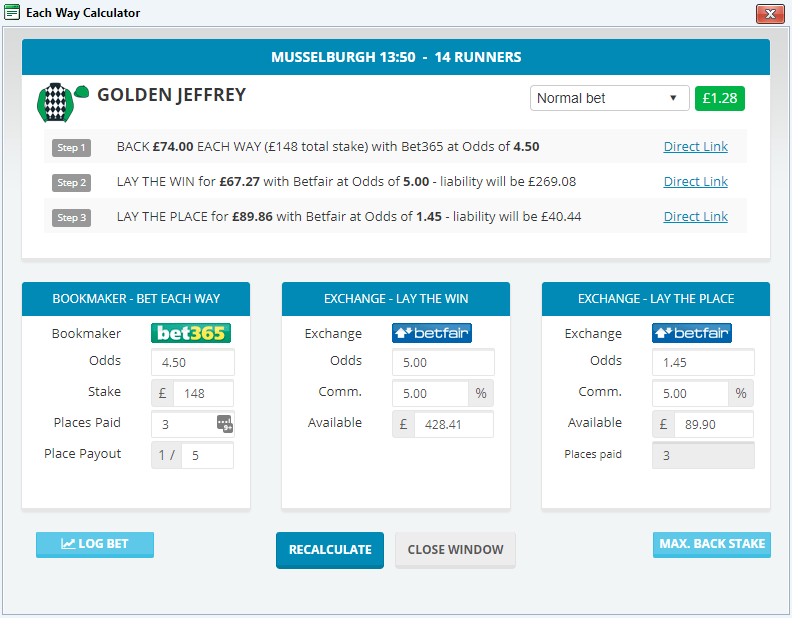
Knowing how to calculate place odds in mathematics gives me an edge over casual punters. I can spot value opportunities others miss by doing my own odds calculations.
Using Probability to Determine True Place Value
The calculation of true place odds starts with win odds and applies the right fraction. Let’s say a horse is priced at 4/1 in an 8-runner race with 1/5 place terms. I divide the original odds by the place fraction: 4 ÷ 5 = 0.8/1 (or 1.8 in decimal). This number shows my bet’s mathematical return on the place portion.
The magic happens when you match this calculated value against the true probability of placing. A selection priced between 4/1 and 7/1 has about a 52-53% chance of placing in races with 8+ runners paying three places. You’ve found value if your calculated place odds suggest a lower probability.
Steps to calculate place probabilities:
- Determine the win probability (1 ÷ win odds)
- Calculate implied place probability based on race conditions
- Compare with bookmaker’s implied place probability
- Bet when your calculated probability exceeds the bookmaker’s implied odds
Tools and Calculators for Each Way Betting
Online calculators make these calculations simple. These tools are a great way to get quick results – just input your stake, odds, and place terms, and see your expected returns instantly. They work great, especially when you have different scenarios to consider before placing bets.
Advanced calculators can compare implied probabilities between bookmakers and show value opportunities. This helps you spot when bookmakers have underestimated a horse’s place chances.
Comparing Your Odds to Bookmaker Offerings
My first step is checking the place-only market on betting exchanges to understand true place probability. Take a horse offered at 9/2 (5.5) for a win with 1/5 place terms – the calculated place odds would be 1.9. The exchange might show the true place odds at 1.6 though.
Bookmakers often underprice place odds because they need to maintain a fixed relationship between win and place returns. This creates opportunities in races with strong favorites where second and third favorites have great place chances.
The quickest way to compare involves calculating the expected value: (True Probability × Odds) – 1. A positive number means you’ve found a value bet.
Implement Strategic Bankroll Management
Sound financial discipline is the foundation of successful each way betting. Your bankroll management strategy determines success more than sophisticated selection methods.
Stake Sizing for Each Way Bets
Each way betting needs double the stake compared to win-only wagers. A £5 each way bet costs £10—£5 on the win and £5 on the place—making proper stake sizing vital. Professional punters suggest these guidelines:
- Standard bets should limit each way stakes to 5% of your total bankroll
- Higher-risk selections or volatile markets need reduced stakes of 0.5-1%
- Longshots require lower stakes to keep your bankroll sustainable
Your budget needs careful planning since each way betting becomes expensive quickly with doubled stakes. A £500 bankroll means £2.50-£5 maximum bets (£1.25-£2.50 each way).
Balancing Win-Only and Each Way Bets
The strategic mixing of win-only and each way bets often brings better profits than using just one approach. Field size changes matter—a 5-runner race that loses a competitor turns your each way bet into win-only automatically. Your £2 each way wager (£4 total) becomes a £4 win bet in this case.
Races with 8 or more runners provide a buffer against these non-runner issues. Of course, keeping track of your betting history helps you see which approach works best for different race types and conditions.
Recovery Strategies After Losing Streaks
A structured recovery approach helps maintain discipline during inevitable downswings. You could start with an original stake of 2% and activate a recovery system after losses. Spreading your deficit across several predetermined bets lets you recover without increasing exposure dramatically.
All the same, recovery systems need extreme caution. Many punters make things worse by chasing losses with bigger stakes, which only increases risk without improving their chances. Long-term profits come from accepting losses as part of the process rather than trying to avoid them completely.
Leverage Each Way Betting in Specific Race Types
Race types can make a huge difference in each way betting success. You’ll find profitable opportunities that most punters miss when you understand the unique features and place terms of different racing formats.
Each Way Strategy for Handicap Races
Handicap races give you better each way terms than non-handicaps, which makes them great targets for smart betting. These races make up over 6,000 events each year. They level the playing field by allocating weights based on official handicap ratings. The place terms structure gives you a real advantage:
- 12-15 runners: Three places at 1/4 odds
- 16+ runners: Four places at 1/4 odds
Look for races with exactly 16 runners – these are sweet spots where bookmakers must pay four places. You should also target handicaps with strong favorites because they create better place odds for second and third favorites.
Keep an eye on horses that got their handicap rating recently. They often run with incorrect marks. Watch previous races to spot jockeys who try to reduce winning margins. This gives you useful insights that you won’t see just by looking at the odds.
National Hunt vs. Flat Racing Approaches
Jump racing gives you better each way value than flat racing. The stats show that outsiders win more often in jump races, and that’s why each way betting is more common here. More variables come into play – fences, hurdles, and stamina needs – which lead to surprising outcomes.
The horse’s skills and track features matter most in jumps betting. Speed, endurance, and jumping ability can make or break a race.
Flat racing is more about pure speed and strength, making results more predictable. You need to watch trainers and jockeys who know these events inside out. The predictable nature of flat racing usually means shorter odds and fewer real outsiders.
All-Weather Racing Considerations
All-weather racing opens up special opportunities for each way betting. Racing happens all year on artificial surfaces at seven UK and Irish tracks.
Different track surfaces can really affect how horses perform. Some horses do great at one all-weather venue but struggle at others. A smart move is to back horses that return to tracks where they’ve won before.
Class matters a lot in all-weather races. Most races are class 4 or below, and horses often keep winning until handicappers catch up. Be careful with horses moving up in class – this usually ends their winning streak. Weather plays its part too. Temperature changes can help frontrunners or hold-up horses do better.
Combine Each Way Betting with Other Bet Types
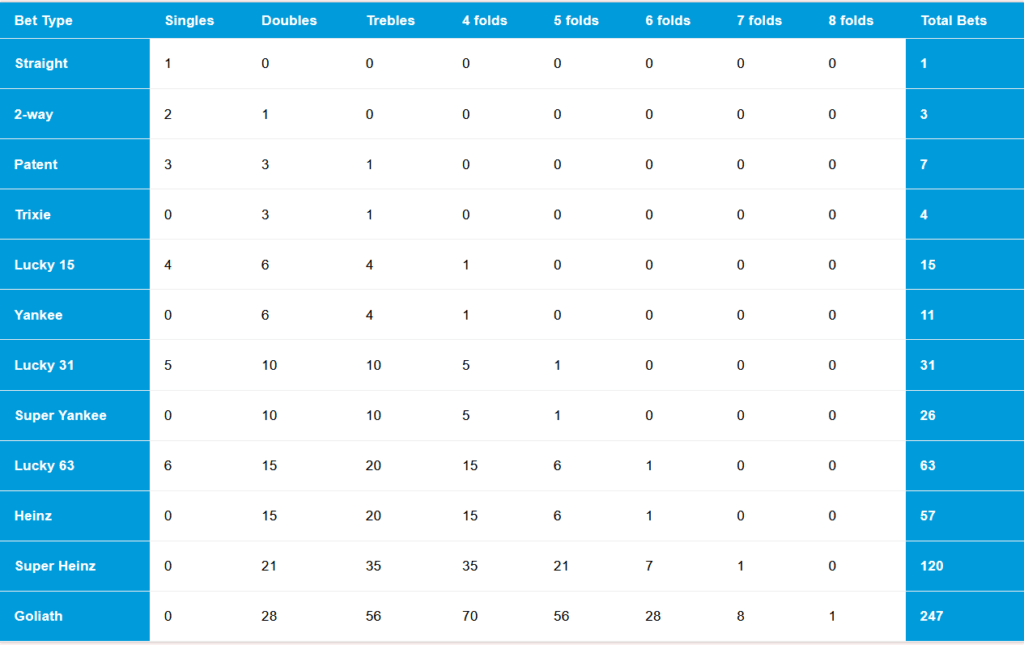
Expert punters increase their each way betting returns by combining this approach with other wagering methods. This strategic combination creates opportunities to boost profits and manage risk more effectively.
Each Way Doubles and Trebles Strategy
Each way doubles and trebles combine multiple each way selections into a single bet. An each way double consists of four separate bets—two win bets and two place bets. A £5 each way double (£10 total) would place £2.50 on both horses to win and £2.50 on both to place. Maximum payout comes when all selections win, but you still profit if some merely place.
Trebles make the mathematics more complex. A £10 each way treble on three horses creates a £20 total stake—£10 on all three to win and £10 on all three to place. Without doubt, these multiples are a big deal as it means that returns exceed singles, though they come with higher risk.
Creating Balanced Betting Portfolios
Smart punters treat their wagers as investments within a diversified portfolio. Combining sports like horse racing and football helps limit exposure and spread risk. The core elements include:
- Systematic selection approach using value betting principles
- Balanced risk across different bet types and sports
- Performance tracking to spot profitable patterns
Careful administration becomes essential with multiple bet types. This approach helps neutralize losing streaks that could otherwise drain your bankroll.
Split Stakes Between Win and Each Way
Split betting provides alternative approaches to standard each way wagering. punters can customize the ratio between win and place markets instead of placing a single each way bet with a bookmaker. This flexibility allows:
- Higher win portion weighting for stronger selections
- Greater place stakes emphasis with moderate confidence
- Stake distributions that adapt to changing conditions
Splitting stakes offers better mathematical value than traditional each way betting for high-odds selections. This strategy works best with favorable place terms, especially during enhanced place promotions at major racing festivals.
Track and Analyze Your Each Way Performance
Analytical insights separate casual punters from consistent winners in each way betting. Smart punters know that careful tracking helps identify profitable patterns and avoid common pitfalls.
Setting Up a Betting Journal
A well-laid-out betting journal improves your each way betting performance. Your journal should track simple information including:
- Selection details (horse, race, date)
- Odds and place terms
- Stake amount and outcome
- Field size and race type
You should add variables like jockey, trainer, and course conditions because these often show profitable patterns over time. Digital spreadsheets work better than paper records and let you sort, filter, and analyze data quickly.
Key Metrics to Monitor
Beyond wins and losses, specific metrics give you deeper insights into your each way betting performance:
Strike Rate & Required Strike Rate: Compare your actual win percentage against the rate needed to break even. This shows whether your selection method has a real edge.
ROI (Return on Investment): Divide profit by total stakes to measure percentage returns.
Edge: This shows your advantage over the market and should stay positive long-term.
Expected Losing Sequence (E.L.S.): Learning about potential downswings helps you manage your bankroll better.
Drawdown Analysis: Track your worst-case losses in both money value and percentage terms. This reveals the best staking approaches.
Using Data to Refine Your Strategy
Once you have enough data, filter it to spot profitable patterns. Try to find an edge with fewer filters. This keeps your data set large while building a small advantage.
Watch out for “back fitting” – too many filters on historical data create patterns that won’t predict future results. You need large sample sizes for statistical significance. The more history you have, the more you can trust your findings.
Monte Carlo simulations are another powerful tool that runs thousands of random scenarios based on your betting data to show likely outcomes. This highlights potential risks, including bankruptcy probability, and leads to smarter decisions.
Note that good tracking isn’t just about recording results. It helps you systematically find your edge and improve your approach.
Exploit Bookmaker Special Offers
Smart punters know that bookmaker offers can mean the difference between long-term losses and green profits in each way betting. Bookmakers keep offering promotions that create mathematical edges for each way punters who use them strategically.
Extra Place Promotions
Extra place promotions pay out on more positions than standard place terms. The biggest races often see bookmakers boost their place offerings. They sometimes pay up to eight places on events like the Grand National. Your chances of getting returns on selections improve substantially this way.
Bookmakers that offer five places instead of four with 1/5 odds reduction in handicaps create a negative overround (around -10%) in 16-runner races. The math works in your favor. These promotions make each way betting the best choice in most cases.
A profitable strategy involves:
- Look for races where bookmakers offer extra places while betting exchanges stick to standard terms
- Making each way bets with bookmakers that offer better terms
- Finding the best place terms for specific races by comparing different bookmakers
Best Odds Guaranteed Effect on Each Way Value
Best Odds Guaranteed (BOG) will give a higher price between your taken odds and the Starting Price. To cite an instance, you’ll get paid at 4/1 if you take early odds of 3/1 and the SP moves to 4/1. This applies to both win and place parts of your bet for each way punters.
BOG protects you against price movements and lets you lock in early value. Most big bookmakers give this concession on UK and Irish racing from 8 am on race day. This works for both win and each way markets.
Bookmaker-Specific Each Way Advantages
Bookmakers are a great way to get other concessions for each way punters beyond standard promotions:
Free bet promotions used on each way bets let you explore longer odds selections with less risk. Money-back specials also give you insurance if your selection just misses placing.
Most promotions work as customer acquisition tools, especially during major racing festivals when bookmakers compete harder. Remember one crucial point – never take enhanced place terms if the win prices drop too much.
Adapt Each Way Strategy to Major Racing Festivals

Big racing festivals just need specific each way betting strategies. Bookmakers compete hard at these events, which creates great value chances that smart punters can use to their advantage.
Cheltenham Festival Each Way Approach
Bookmakers at Cheltenham Festival compete aggressively to get punters by offering better each way terms. We mostly see this through extra places or better fractional odds. Smart punters should check multiple bookmakers to find the best value before placing any each way bet during Cheltenham.
You’ll find bookmakers offering up to seven places in certain Cheltenham races, which really helps your chances of getting returns. The Fred Winter Handicap is a great chance to get value with enhanced place terms. Recent festival numbers show punters love each way betting just as much as win-only betting in many Cheltenham races.
Grand National and Other Big Handicaps
The Grand National stands out as the ultimate each way betting event, with about 75% of all bets being each way wagers. Standard industry place terms for the Grand National (with 16+ runners) are 1/4 odds for four places, but most major bookmakers go well beyond this.
Some bookmakers are offering seven or even eight places on the 2025 Grand National, which is a big deal as it means that the mathematical value is exceptional. Betfred leads the pack by offering seven places on the 2025 Grand National.
International Racing Events
International racing events need extra research for each way betting success. Form guides, track conditions, and jockey-trainer teams work differently in various regions, so you’ll need to do your homework before betting.
Smart bankroll management becomes crucial here. I only risk a small part of my bankroll per race with unfamiliar horses and tracks. Early prices on international events often give better value, as odds tend to drop sharply close to race time.
Psychological Discipline for Each Way Betting
Mental discipline separates consistent winners from those who struggle in each way betting. Success depends more on psychological aspects than technical knowledge, whatever their mathematical proficiency.
Avoiding Common Emotional Pitfalls
Raw emotions can derail even the most sophisticated each way betting strategies. Research shows that 54.49% of UK punters trust their gut instincts when placing sports bets. This emotional mindset leads to several common traps:
Loss Chasing – Punters increase their stakes after losses to recover, which results in even greater losses. Loss aversion creates this behavior, where losing hurts more than winning feels good.
FOMO – Impulsive bets happen due to the fear of missing out, usually on heavily-backed horses without proper analysis. Major festivals amplify this reaction as excitement levels reach their peak.
Post-Win Overconfidence – Winners often feel invincible and take riskier bets. Your emotional balance matters just as much during winning streaks as it does during losses.
Maintaining Consistency in Approach
Each way betting demands steadfast discipline through inevitable variance. A mathematical edge emerges only after hundreds of bets in the long run. Short-term results often disappoint, causing many punters to abandon profitable strategies too early.
Fixed staking plans help prevent emotions from interfering with logical decisions. You should also:
- Look at each way bets as two separate propositions (win and place) with different mathematical characteristics
- Think of betting as long-term investing rather than gambling
- Take regular breaks to keep your view fresh and avoid burnout
When to Trust Your Analysis Over Gut Feeling
Analytical insights beat intuition in each way betting. Gut feelings might be right sometimes but usually come from biases rather than subconscious pattern recognition. UK punters know the financial risks of trusting intuition – about 84.43% acknowledge this, yet most still do it.
Professional punters base their betting decisions on probability, value, and complete analysis. Sound mathematical principles should always outweigh gut feelings, especially regarding each way value.
Comparison Table
| Betting Tip | Key Focus | Benefit | Effect | Difficulty |
|---|---|---|---|---|
| Understanding Each Way Betting Fundamentals | Simple mechanics of win/place betting | Safety net for returns | Two separate bets with divided stakes | Low |
| Identify Value in Short-Priced Favorites | Horses at odds under 7/1 | Better mathematical edge | Better place probability for shorter odds | Medium |
| Avoid Each Way Traps with Long Odds | Risks of high-odds selections | Preventing value loss | Diminishing returns beyond 8/1 odds | Low |
| Analyze Field Size | Number of runners’ effect | Best place terms | Changes in place probability based on field size | Medium |
| Master Place Terms | Race type differences | Better returns through term selection | Different fractional odds across race types | High |
| Calculate Your Own Place Odds | Probability assessment | Finding value opportunities | Comparison of true vs. offered odds | High |
| Use Smart Bankroll Management | Money discipline | Long-term stability | 5% maximum stake recommendation | Medium |
| Use Each Way Betting in Race Types | Race format details | Taking format advantages | Different terms for handicap vs. non-handicap | High |
| Combine Each Way Betting | Multiple bet integration | Risk spreading | Complex calculations for doubles/trebles | High |
| Track and Analyze Performance | Analytical decisions | Pattern identification | ROI and strike rate calculations | Medium |
| Use Bookmaker Special Offers | Promotional advantages | Better place terms | Improved mathematical edge through extra places | Medium |
| Adapt to Racing Festivals | Event-specific strategy | Better promotional terms | Multiple place opportunities | Medium |
| Psychological Discipline | Emotional control | Steady decision-making | Less emotional bias | Low |
Each Way Betting Tips – My Conclusion
Each way betting gives you a powerful edge in horse racing profits if you use it strategically. My largest longitudinal study and experience show that you just need to become skilled at both technical and psychological aspects to succeed with this betting method.
Smart punters look for races with 8-12 runners. They target horses priced between 4/1 and 7/1 where the mathematical edge is highest. My research shows these picks give you the best balance of win probability and place value. This works even better when you get boosted place terms during major festivals.
You can’t identify profitable patterns without proper record-keeping. My results show that disciplined bankroll management works best. Limiting stakes to 5% of total funds protects against inevitable variance and allows steady growth.
Mental discipline is a vital factor. Successful each way betting needs steadfast dedication to mathematical principles and value-based selection methods instead of chasing losses or following hunches.
These 13 tips set winning punters apart from others. The long-term rewards are worth the effort even though it takes dedication and patience. Note that each way betting success comes from applying proven methods consistently across hundreds of carefully chosen races, not from occasional lucky wins.
Each Way Betting Tips – Your FAQs
Q1. What is each way betting and how does it work? Each way betting involves placing two separate bets – one for the horse to win and one for it to place. If your horse wins, you collect on both bets. If it only places, you still receive a return on the place portion at a fraction of the win odds.
Q2. When is each way betting most profitable? Each way betting tends to be most profitable on horses priced between 4/1 and 7/1 in races with 8-12 runners. This range offers the best balance between win probability and place value, especially when combined with enhanced place terms.
Q3. How important is analyzing field size for each way bets? Analyzing field size is crucial as it directly impacts place terms. Races with exactly 8 runners often provide the best value, while large fields can significantly reduce your chances of a place return. Always check the specific terms for each race.
Q4. Should I use each way betting for longshots? Generally, each way betting becomes less favorable as odds increase beyond 8/1. For longshots, consider alternative strategies like win-only bets or split stakes approaches rather than standard each way wagers.
Q5. How can I track my each way betting performance? Keep a detailed betting journal recording selection details, odds, stakes, outcomes, and race conditions. Monitor key metrics like strike rate, ROI, and drawdown to identify profitable patterns and refine your strategy over time.




